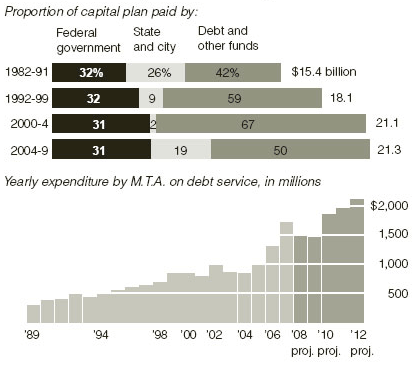The Biggest Fare Hike Factor? It Could Be MTA Debt

Saturday’s Times delved into the history of the MTA’s mounting debt burden, which, along with rising fuel costs and plummeting revenues from the real estate transactions tax, has severely squeezed the authority’s finances:
Debt payments are the system’s largest single cost after payroll, and
by 2012 they will account for one of every five dollars the authority
spends.The problems facing the agency now are no surprise. Independent
analysts and the agency’s own financial planners have warned of rising
debt costs for years — most loudly and urgently after a huge debt
restructuring in 2000.Called at the time the largest deal in
the history of American municipal finance, the refinancing — taking
advantage of lower interest rates — led to lower debt payments. The
agency, facing political resistance to fare increases and new taxes,
decided to sell new bonds to finance the system’s first major expansion
since the 1930s. In a few short years, the debt burden it had amassed
over nearly 20 years had doubled.
Before the debt restructuring, the article notes, state and city contributions to the MTA capital budget fell to historic lows during the 1990s, causing the authority to rely more on borrowing.
When former MTA chairman Richard Ravitch proposed the authority’s first bonds, issued in 1982, the cash made possible investments that revived a transit system in crisis. Now all eyes are again fixed on Ravitch, appointed by Governor Paterson to find a way out of the MTA’s current funding woes. With the state and city facing budget crunches of their own, where might the money for transit come from?
Graphic: New York Times
